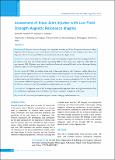Please use this identifier to cite or link to this item:
https://hdl.handle.net/20.500.14356/1702| Title: | Assessment of Knee Joint Injuries with Low Field Strength Magnetic Resonance Imaging |
| Authors: | Panta, O B Neupane, N P Songmen, S Gurung, G |
| Citation: | PantaO. B., NeupaneN. P., SongmenS., & GurungG. (2016). Assessment of Knee Joint Injuries with Low Field Strength Magnetic Resonance Imaging. Journal of Nepal Health Research Council, 14(2). https://doi.org/10.33314/jnhrc.v14i2.795 |
| Issue Date: | 2016 |
| Publisher: | Nepal Health Research Council |
| Article Type: | Original Article |
| Keywords: | ACL tear Knee Joint injuries Magnetic resonance imaging Medial meniscus tear |
| Series/Report no.: | May-Aug, 2016;795 |
| Abstract: | Abstract Background: Magnetic Resonance Imaging is an appropriate screening tool before therapeutic arthroscopy, making diagnostic arthroscopy unnecessary in most patients. This study aims to evaluate the MRI findings in knee injuries and diagnostic value of low Strength MRI for assessing Meniscal and cruciate ligament tear. Methods: A cross sectional study was conducted on patients undergoing “Magnetic Resonance Imaging of the Knee†for injuries of the knee and excluded patients undergoing MRI for other causes, poor diagnostic quality MRI and post operative MRI. All patients were interviewed for mechanism of injury and followed up for arthroscopic findings. Statistical analysis was doe using IBM SPSS 20.0. Results: A total of 81 MRIs was included in the study. Arthroscopic finding of only 32 patients could be followed up. Anterior cruciate ligament (ACL) tear was the most common internal ligament tear accounting for 34(42%) of cases followed by medial meniscus tear in 33(40.7%). Twisting 14( 42.4%)was the most common mechanism involved in medial meniscus tear while combined mechanism of injury was most common mechanism for ACL tear 16( 47.05%). The sensitivity of MRI for diagnosis of ACL tear and medial meniscus tear was 96.3% and 94.7% respectively. Specificity for ACL tear was however only 80% and that for medial meniscus tear was 100%. Conclusions: The diagnostic value of MRI for diagnosing internal derangement of knee was high even with a low Tesla (0.3 T) MRI thus emphasizing the role of MRI as a non-invasive alternative to diagnostic arthroscopy. Keywords: ACL tear; knee Joint injuries; magnetic resonance imaging; medial meniscus tear. |
| Description: | Original Article |
| URI: | http://103.69.126.140:8080/handle/20.500.14356/1702 |
| ISSN: | Print ISSN: 1727-5482; Online ISSN: 1999-6217 |
| Appears in Collections: | Vol. 14 No. 2 Issue 33 May-Aug 2016 |
Files in This Item:
| File | Description | Size | Format | |
|---|---|---|---|---|
| 795-Article Text-1472-2-10-20170528.pdf | Fulltext Download | 325.84 kB | Adobe PDF |  View/Open |
Items in DSpace are protected by copyright, with all rights reserved, unless otherwise indicated.
